Dimorphotheca sinuata
When it comes to enjoyable South African exports, the cape marigold comes to mind.
Dimorphotheca sinuata is a self-seeding daisy-like annual in the aster family native to Namibia and Cape Province, South Africa.

We link to vendors to help you find relevant products. If you buy from one of our links, we may earn a commission.
Introduced to Arizona in the 1940s, it is suited to cultivation in USDA Hardiness Zones 2 to 11.
In its native habitat and similar frost-free zones, it blooms from spring to winter. In other regions, it is a sensation from summer to frost.
Please note that D. sinuata naturalizes readily and has done so in Arizona, California, and Oregon.
Unfortunately, it can become invasive and is classified as an emerging environmental weed in California and Australia, and invasive in the Dominican Republic.
Also noteworthy, there is another daisy-like species, perennial Osteospermum, that’s sometimes called cape marigold.
Once classified under the Dimorphotheca umbrella, it is now described as part of a separate genus and is not the topic of this guide.
Read on for all you need to know to grow and care for annual cape marigold, D. sinuata, in your outdoor living space – including a tip for curbing its aggressive tendencies.
Here’s what we’ll cover:
What You’ll Learn
Let’s start with a bit of background.
Cultivation and History
Like the rainbow nation it comes from – so dubbed by Archbishop Desmond Tutu to describe South Africa’s diverse people – cape marigold comes in a varied color palette that includes apricot, orange, salmon, white, and yellow, sometimes with striking purple accents.
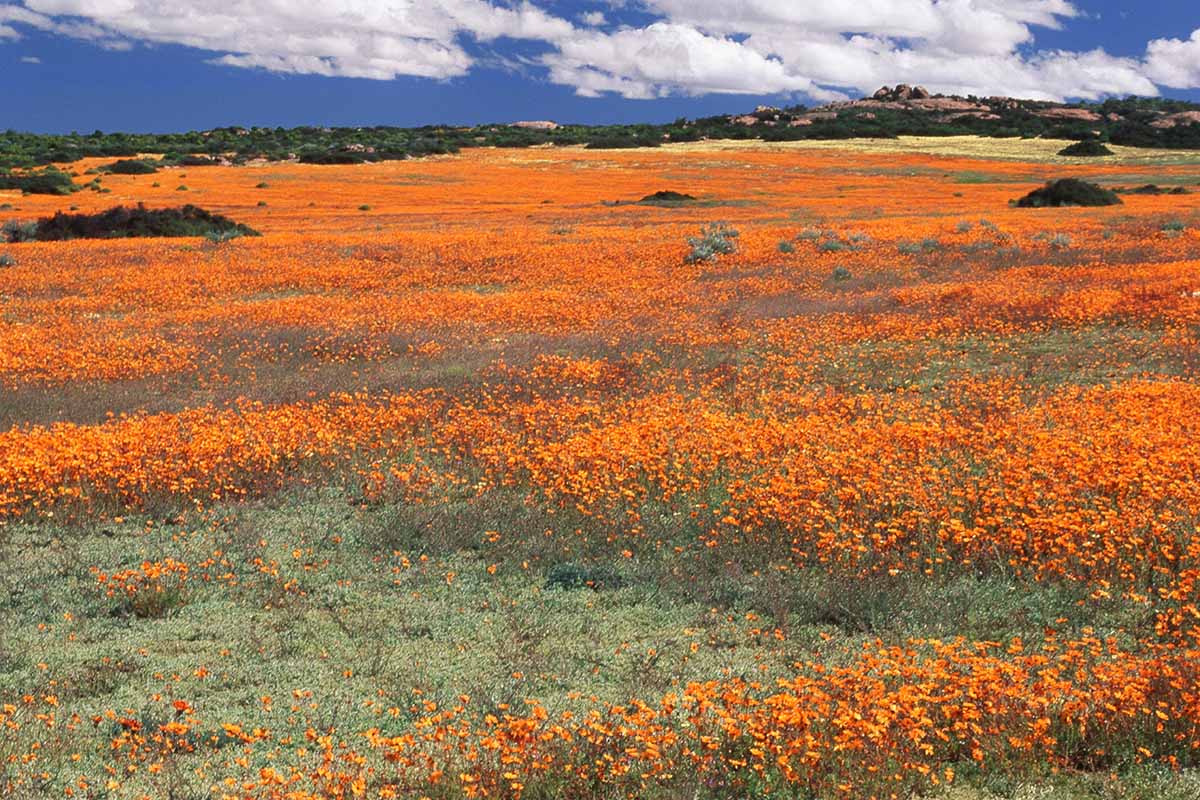
Mature dimensions are four to 12 inches tall and wide. Plants have an upright growth habit and upturned flowers.
Reddish stems bear a single floret of petal-like rays surrounding a central disc measuring approximately three inches across. The flowers open on sunny days and close at night.
Dimorpotheca refers to the two types of fruits or seeds produced by the ray and disc flowers. Plants self-sow to increase their landscape footprint yearly.
The leaves have glandular hairs, a narrow lance-like shape, and a light green color. Sinuata refers to the alternating rounded and notched leaf margins, aka serrating.
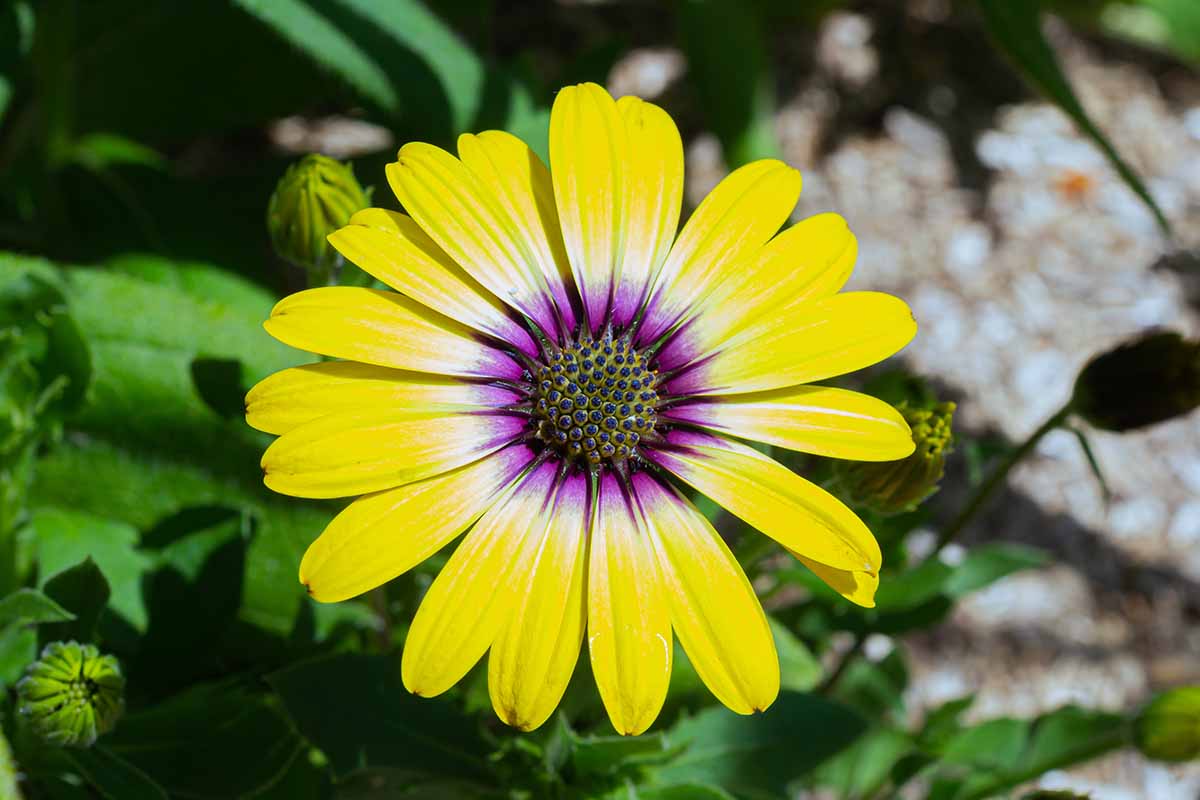
Swiss botanist Augustin Pyramus de Candolle assigned cape marigold its botanical classification, D. sinuata, in 1838.
Cape marigold made its way to Arizona in the 1940s. Since the 1970s, it has naturalized, as mentioned, in Arizona, California, and Oregon, where it escaped cultivation via self-sown seeds.
Cape Marigold Plant Propagation
Cape marigold may be grown from seed. You can buy them or collect them from existing plants at the end of the growing season, just before the wind carries them off to places where they’ll germinate the following year.
In a frost-free climate, you can sow seeds directly into the garden or containers in late fall to early winter.
Elsewhere, it’s best to start seeds indoors about eight weeks before your region’s last spring frost date.
Use biodegradable seed-starter peat pots like these from Kate Naturals, available via Amazon.

Kate Naturals Seed Starter Peat Pots
Each package contains 50 biodegradable seed-starter cells and 10 plant markers.
Fill each pot three-quarters full with potting medium. You might want to use a gritty cactus and succulent mix. Moisten the medium.
Sprinkle two or three of the tiny seeds onto the moist medium.
Press them gently into the medium, no more than 1/16 of an inch deep.
Place the pots in bright indirect sunlight.
Keep the medium moist but not soggy.
Thin them to one seedling per pot when they are about two inches tall.
Continue to maintain even moisture until the seedlings are four inches tall. Once they achieve this height, you can let the pots dry out completely between waterings.
After the last spring frost date, acclimate the seedlings to the outdoors. Set the pots in a sheltered, sunny spot for a few hours each day for a week. At that point, they can be transplanted outside.
How to Grow Cape Marigold Flowers
Once the danger of frost passes, it’s time to head to the garden.
Choose a location with full sun.
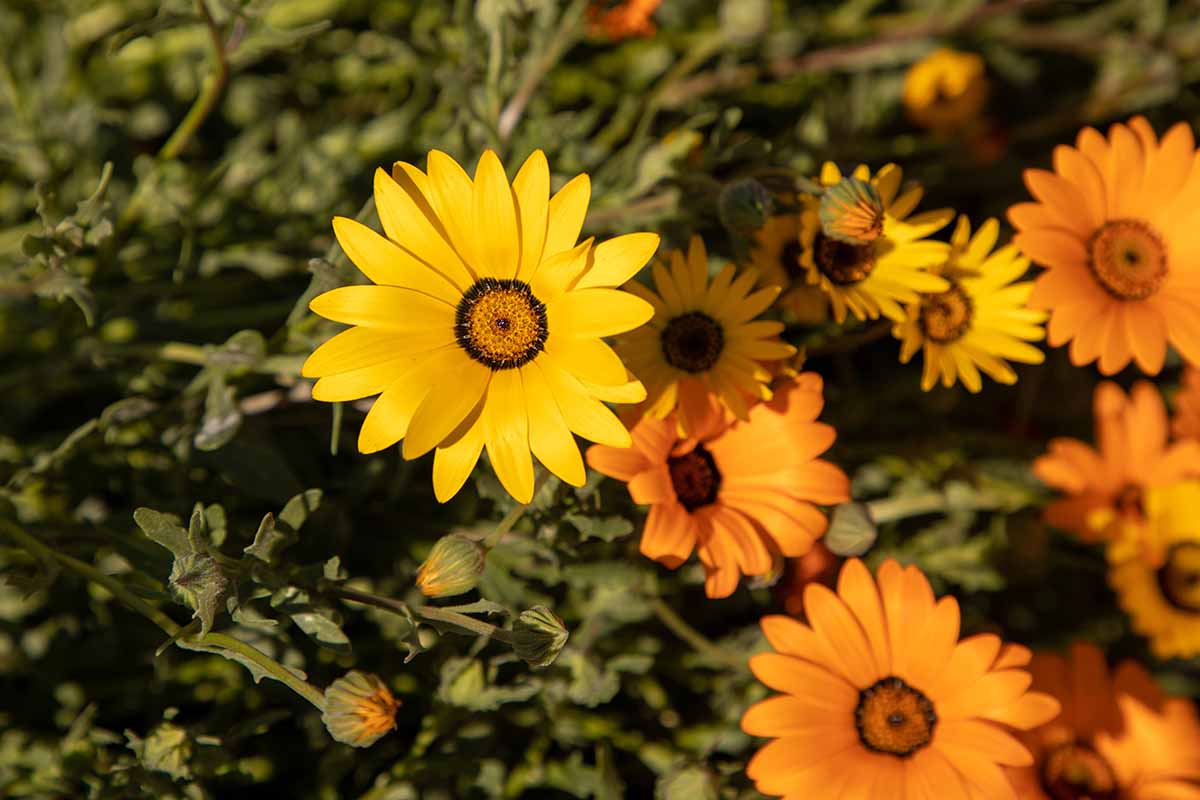
The ideal soil is average to poor, sandy, and well-draining. A pH of 6.5 to 8.4 is comparable with that of cape marigold’s native lands.
Avoid rich soil and fertilizer. They will promote legginess and sprawling rather than upright stems and upturned blossoms.
Space plants eight to 12 inches apart to accommodate mature dimensions. Avoid overcrowding, to facilitate airflow and reduce the risk of mildew formation.
Work the soil to a depth of about eight inches until it is crumbly. Remove any rocks, sticks, and other debris.
Settle the biodegradable pots into the soil so the rims are even with the soil surface.
Tamp soil around the pots to secure them and water them in well, taking care to water the soil, not the leaves.
Water weekly in the absence of rain. Take care to avoid overwatering.
Alternatively, transplant the pots into one or more containers with a depth of about eight to 10 inches.
Fill the containers two-thirds to three-quarters full with potting medium.
Set the peat pot rims so the soil surface in the pots is even with the soil surface in the new containers. Backfill around and under the pots as needed to secure them.
Water the soil, not the leaves, until it runs through the drainage holes in the bottom of the containers.
Containers dry out faster than garden soil. Use a moisture meter as a guide and let the soil dry completely between waterings.
Once established, these plants exhibit above-average drought tolerance. However, they prefer temperatures below 80°F and will show signs of wilting and distress at 90°F.
If high temperatures are predicted, water early in the morning to help your plants manage the heat.
Growing Tips
- Start indoors and transplant to the garden or containers post-frost.
- Surface sow, barely covering the seeds.
- Maintain even moisture during germination and establishment.
- Grow in full sun, and poor to average, well-draining soil with a slightly acidic to alkaline pH.
- Avoid rich soil and fertilizer to prevent legginess, and promote upright growth and upturned blossoms.
- Monitor plants for moisture stress when temperatures are 90°F or above.
Maintenance
Keep the garden weeded to avoid creating competition for water and deter pests.
If it doesn’t rain during the week, provide supplemental water as needed to avoid wilting.
Annuals live for one season. In zones that experience frost, they die with the first freeze. In warmer regions, they wither by winter.
Either way, clear away all debris when they are finished to prevent pests and diseases from wintering over in it.
Here’s a tip to curb the spreading caused by self-sowing:
Deadhead the spent blooms throughout the growing season.
Deadheading is the removal of a spent flower stem before the flower loses all of its color. It promotes more flowering and prevents seed formation and dispersal.
The task is easiest with small quantities of plants, like those in containers.
To deadhead, use clean pruners to snip off the stem of a spent flower near a leaf node or at the base of the plant without damaging neighboring foliage.
Cape Marigold Cultivars to Select
When shopping for cape marigolds, reference the Latin name Dimorphotheca sinuata, to ensure you are getting our subject plant.
D. sinuata ‘Mixed Colors’ boasts shades of apricot, canary, and tangerine for a warm-hued display with depth and variation that shows well in mass plantings.
‘Mixed Colors’ seeds are available from True Leaf Market.
D. sinuata ‘Salmon’ has two-toned rays that blush pink at the center and shade gradually to a golden hue, bringing a sunset glow to garden settings.
‘Salmon’ cape marigold seeds are available from Seedville USA via Walmart.
Purple centers draw the eye into the blossoms of white D. sinuata, while the purple undersides of the crisp rays heighten their brilliance with an echo of lavender.
White cape marigold seeds are available from Seedville USA via Walmart.
Managing Pests and Disease
Cape marigold generally has no significant pest or disease issues. However, the following may present themselves:
Western flower thrips, Frankliniella occidentalis, may pose a threat in the American southwest.
Onion thrips, Thrips tabaci, are common in California. Please see our guide to thrips for control information.
In addition, watch for two more widespread and common pests, aphids, and whiteflies.
As for diseases, if the soil becomes oversaturated, the spores of downy mildew and powdery mildew may activate and grow.
Organic neem oil is an insecticide and fungicide that may prove effective against these pests and fungal conditions.
Neem oil kills adult, larvae, and egg-stage pests and suppresses and controls fungal diseases.
Bonide® Neem Oil is available from Arbico Organics in a ready-to-use quart or gallon size, or a one-pint concentrate.
Best Uses for Cape Marigold Flowers
Give this self-sowing annual room to roam to show the species to its best advantage.
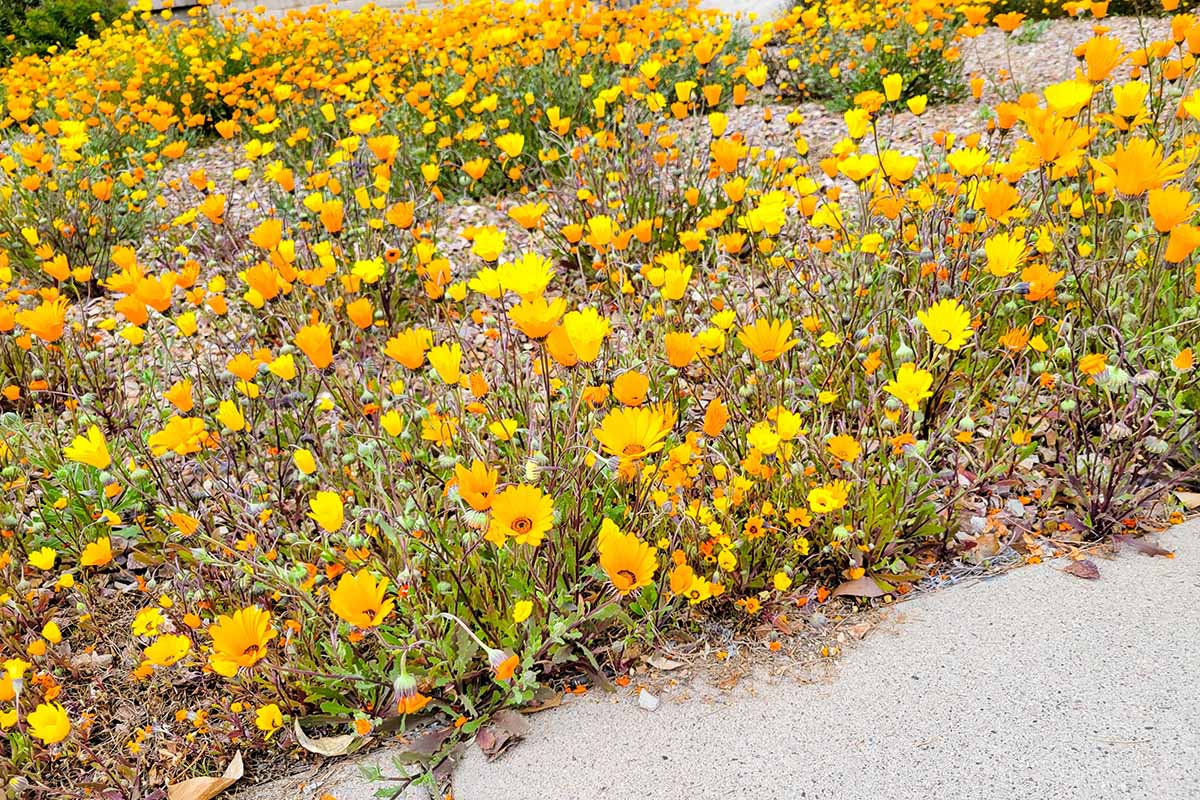
In the warmest zones, mass plant where it can naturalize, creating a low-maintenance, water-wise xeriscape.
Pop it into rock gardens and let it meander along a sidewalk or roadway as a non-fussy ground cover that prevents the erosion of hard-scrabble soil in places where other plants fail to thrive.
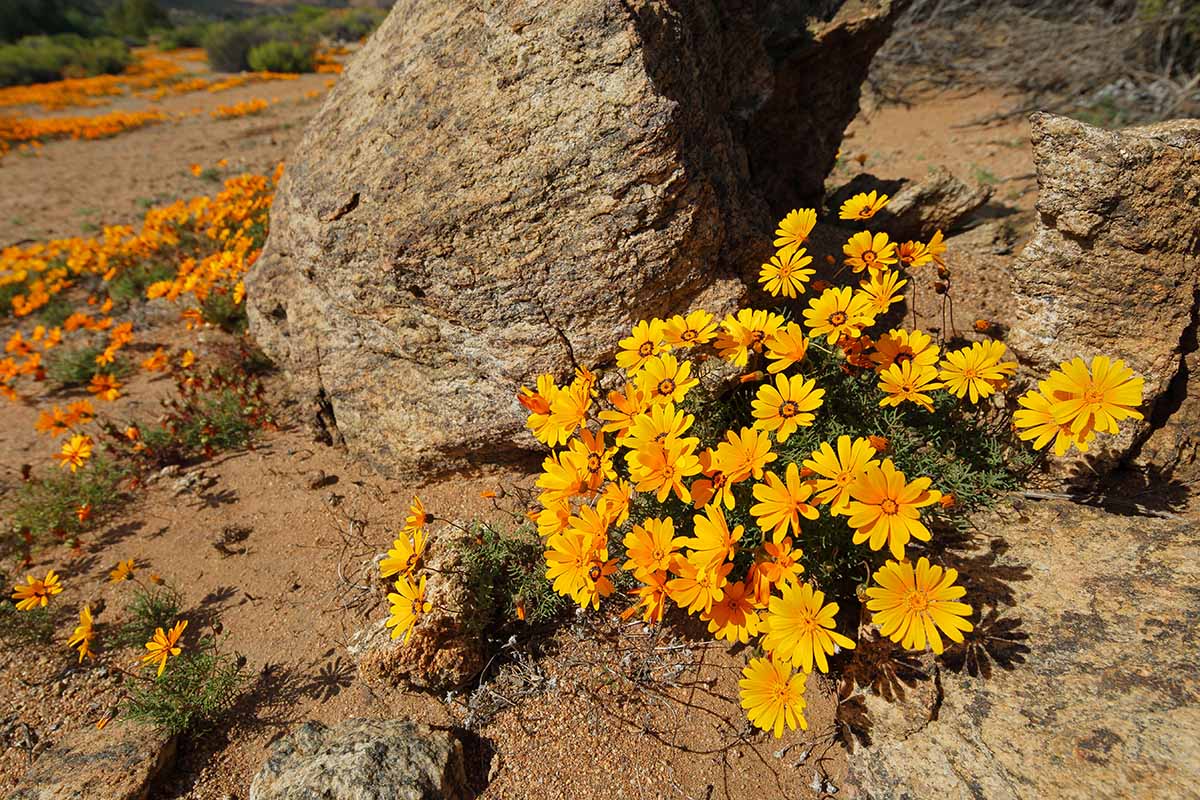
Fill some patio containers for rich color, season-long blooms, easy deadheading, and small-scale enjoyment.
Quick Reference Growing Guide
| Plant Type: | Annual flower | Flower/Foliage Color: | Apricot, orange, salmon, white, yellow; sometimes purple accents/green, reddish |
| Native to: | Cape Province, South Africa, Namibia | Water Needs: | Low to moderate |
| Hardiness (USDA Zones): | 2-11 | Maintenance: | Low |
| Bloom Time/Season: | Spring to winter, depending upon the zone | Tolerance: | Drought |
| Exposure: | Full sun | Soil Type: | Sandy, average to poor |
| Spacing: | 8-12 inches | Soil pH: | 6.5-8.4 |
| Planting Depth: | 1/16 inch (seed) | Soil Drainage: | Well-draining |
| Height: | 4-12 inches | Uses: | Containers, ground cover, mass planting, naturalization, rock gardens, xeriscaping |
| Spread: | 4-12 inches | Family: | Asteraceae |
| Growth Rate: | Fast | Genus: | Dimorpotheca |
| Common Pests and Diseases: | Aphids, thrips, whiteflies; downy mildew, powdery mildew | Species: | Sinuata |
A Taste of Africa
It’s time to add annual self-sowing cape marigold to your garden planner and enjoy a virtual visit to South Africa right in your own backyard!
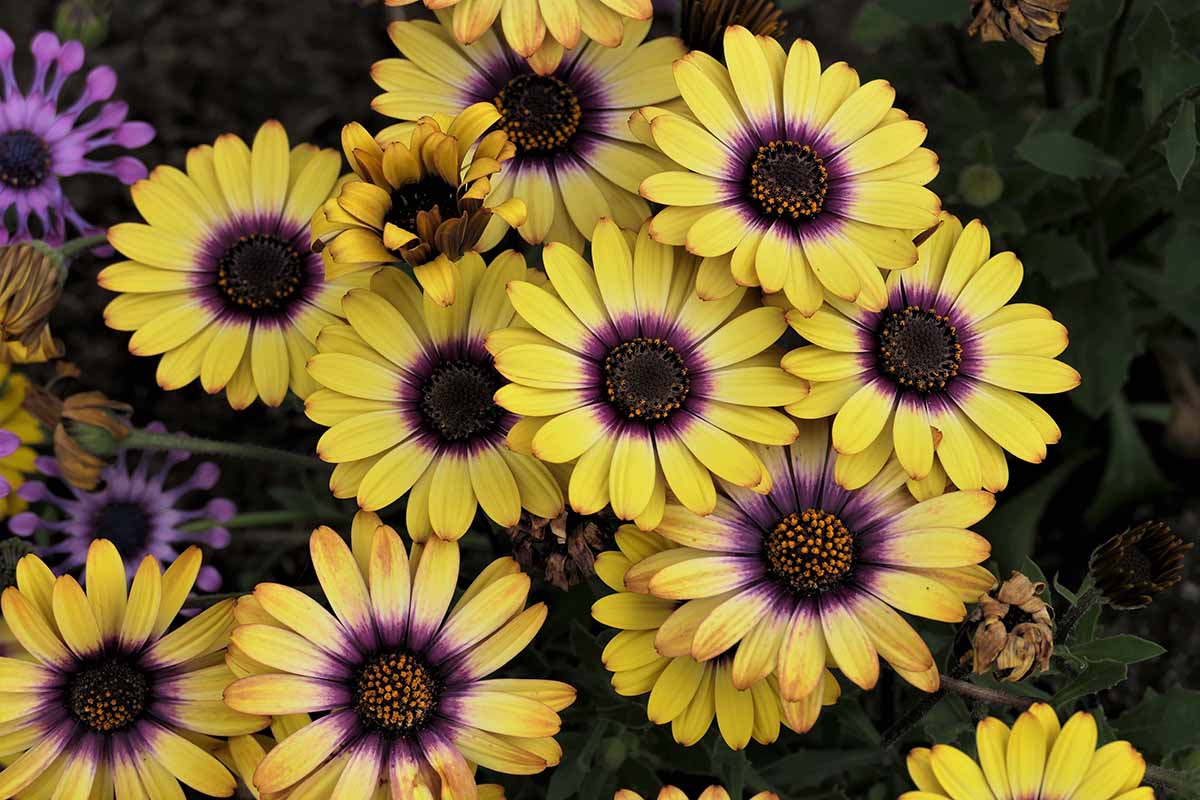
Whether you give these plants room to naturalize or contain them in patio pots, you’ll appreciate cape marigold’s sunny hues and easy-going disposition.
Do you grow this flower in your outdoor living space? Tell us about your experience in the comments section below.
If you enjoyed reading about cape marigold and want to learn about more about growing daisies, we recommend the following:
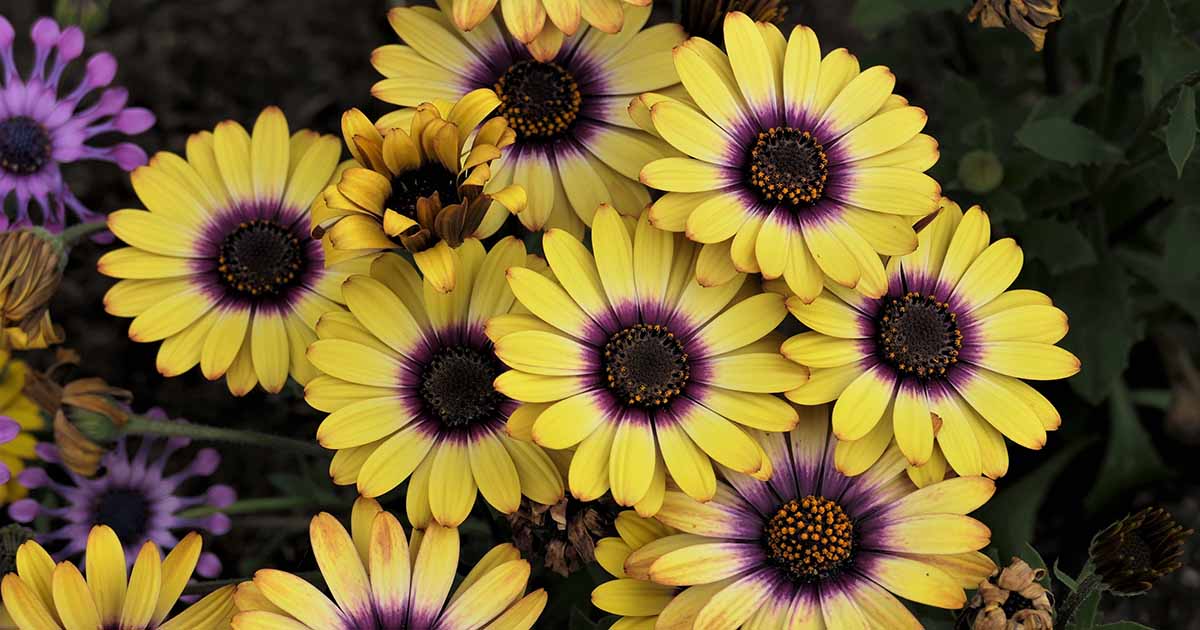
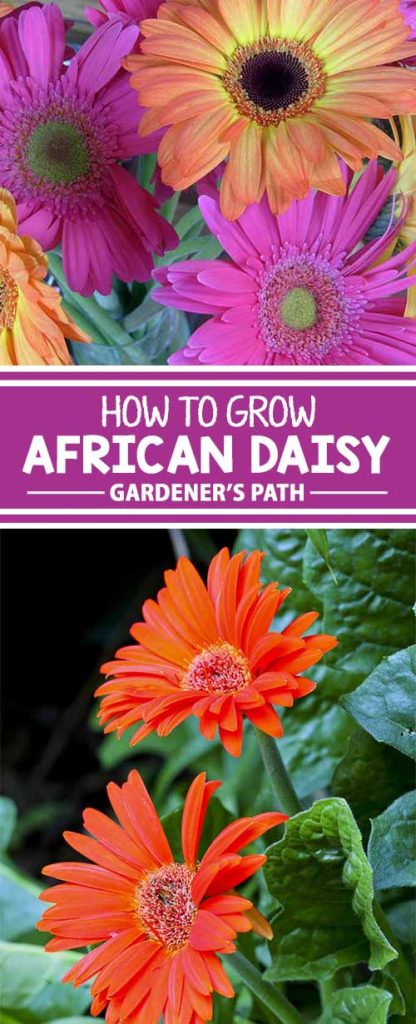
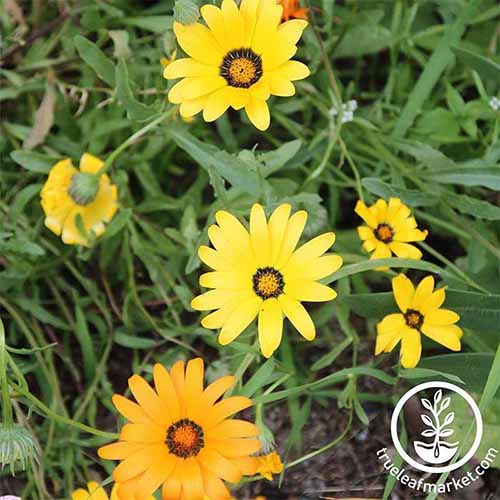
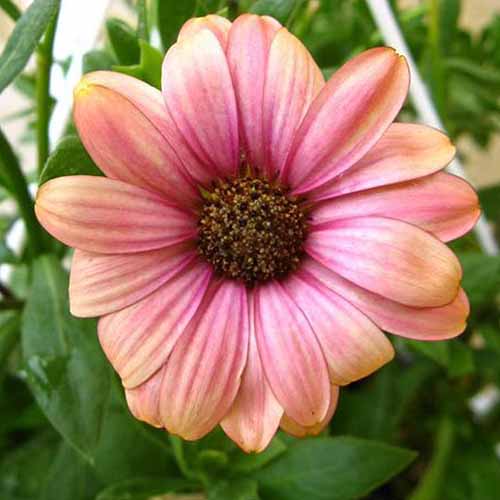
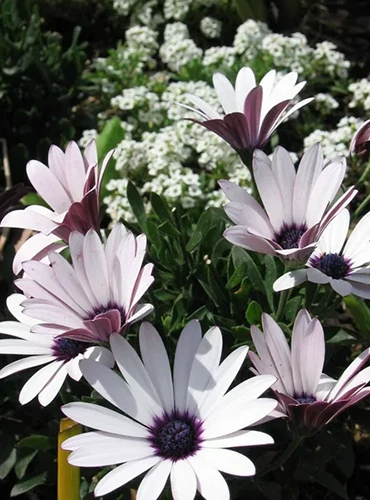
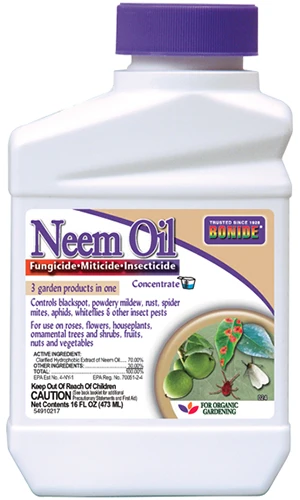
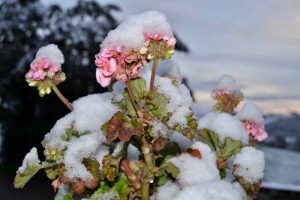
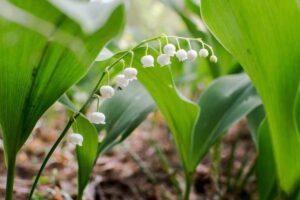
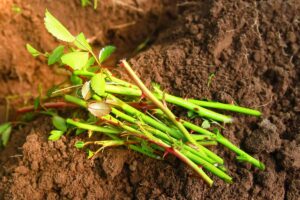
I somewhere acquired what I think are African Daisys. The flowers are brilliant orange, about 3.5 inches across, with thin dark green spearlike leaves. They close up at night and open with bright sun. I’d like to know the name of that particular variety.
Thank you.
Can you upload a photo, Chuck? These flowers do close at night, and there are several different orange cultivars available.
I love gerbera daisies! In my old yard I had what I thought was a perennial version of gerbera daisies. People at the local plant stores thought I was crazy when I’d ask for perennial gerbera daisies. But I couldn’t explain why these daisies kept coming back every year. I did nothing to them. They were so plentiful to cut for inside and have color in the garden. We’ve moved since. But thanks to your article, I now know what to look for in my new yard. AFRICAN DAISIES! Who knew?!